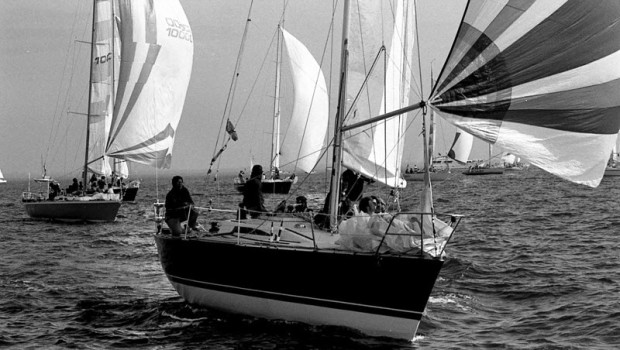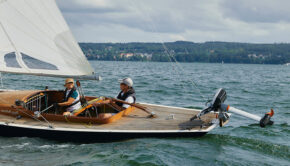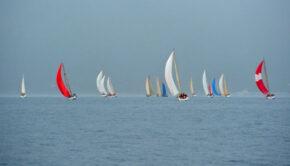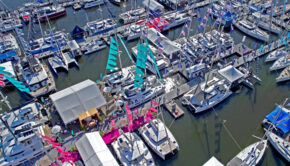The Impact of Professionals in the Sport
Published on January 10th, 2016
by Craig Leweck, Scuttlebutt
The SORC was a phenomenal event, encompassing a couple weeks of winter offshore racing in Florida and the Bahamas. Back when IOR was the international handicap rule, the SORC was an epic showcase of talent and trick boats.
I was lucky to do it in 1985, just before it started to crumble. This story in the Sun Sentinel, published in 1987, discussed then the impact of professionals on the event. Now, nearly 30 years later, where are we?
Sailing is supposed to be an amateur sport. But anybody who sails major campaigns such as the Southern Ocean Racing Conference series knows “pros” play a major role. Some sailing officials think it is time the hypocrisy ends.
Sailing industry professionals have become the “pros” of amateur sailing events. They have come to Fort Lauderdale by the dozens for this week`s continuation of the six-race SORC series. They are sailmakers and boat designers who spend a considerable amount of time sailing for amateur skippers.
While the sailing industry pros are not paid directly for sailing, they make money if they do well.
Sailing industry professionals design boats or make sails for some amateur sailors. The pro`s wares usually come at a higher than normal price with the understanding that he and his factory team will join the amateur skipper for the sailing campaign and the pro`s expenses will be paid. And if the pro does well, his wares will sell and his business will be rewarded with new orders and profits.
It works differently on every boat, and some boats are free of sailing industry pros. But the pros make an impact in the SORC`s high-tech International Offshore Rule division.
“For the average amateur, it can be like going out to play his Sunday golf against Jack Nicklaus,” said Mark Soverel, a North Palm Beach boat designer who is skipper of Locura in this year`s SORC series.
That prospect has driven many of the “true” amateurs out of the SORC series. The number of entries in the SORC has dropped significantly over the last several years. It`s not just the pro`s competitive experience that has driven amateurs away. The pros also have sent the cost of sailing soaring.
The pros have pushed yacht racing to the edge of modern technology. The IOR division is a showcase and proving grounds for the pros` stripped-out racers. The advantages those racers possess come at a great expense.
In an attempt to put some new blood in this year`s SORC series, a new division for cruisers and old boats was created. The new International Measurement System division gives the SORC a pro/am feeling. Still, many “true” amateurs are sticking it out against the sailing industry pros in the IOR division.
Because “pro” isn`t acknowledged in amateur events, another label has evolved. The best of the pros, the high-profile glamour boys of sailing, have become known as “Rock Stars.”
There are mixed emotions about “Rock Stars” and professionalism in the sailing community. There is an appreciation for the advances and glamour the pros bring to sailing, but there`s also a resentment of what their role has become.
“They are very conscious of their image, and they`re very concerned about making a buck,” one SORC participant said. “A lot of them think they`re the hottest thing around,” another said. “They are in a very competitive, cutthroat kind of business. Their egos clash with each other. Sometimes you can see it happening even when they`re on the same boat.”
But it`s the pros who also add color and glamour to sailing campaigns. And, in the long run, make better boats for the average yachtsman.
“With the pros involved, sailing benefits from the ideas and technology that come out of excessive competition,” Soverel said. “Those advances filter down to the amateur in the form of better boats, masts, sails, etcetera.”
Some, however, believe pros should be banned from sailing in amateur events. In the November 1986 issue of Sailing World, sailing industry pro Dave Ullman admitted to sailing 200 days a year. He also said the “(United States Yacht Racing Union) has to legislate the pros out of racing.”
In February 1987, Sailing World published the results of a poll that accompanied the Ullman article. Seventy-five percent of the respondents favored Ullman`s proposal while 25 percent favored a new USYRU proposal and 5 percent favored holding the status quo (some voted for both Ullman and USYRU options).
The USYRU, recognizing the need for change, approved in principle this fall a proposal to set up an appendix to its rules that allows sailing officials to classify their events as commercial, non-commercial or non-classified. USYRU Rule 26 now prohibits commercialism. Advertising logos aren`t allowed on boats, sails, equipment or clothing of participants in USYRU events. The new appendix could open the door to a professional class of sailing.
“I can see how we`re going to have a class for all the rock stars to race against each other,” former North American Laser and Finn class champion Tom Lihan said. “The sailmakers and designers are finding it increasingly difficult to find people to commit the time and money it takes to create a fast boat.”
Source: Sun Sentinel









 We’ll keep your information safe.
We’ll keep your information safe.